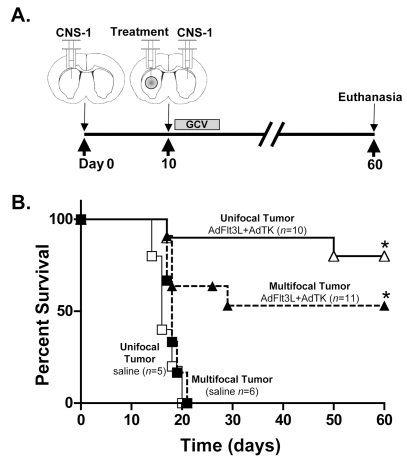Fig. 3.
Efficacy of human soluble FMS-like tyrosine kinase 3 ligand (Flt3L) and herpes simplex virus type 1–thymidine kinase (TK)-mediated gene therapy in a model of multifocal intracranial glioblastoma multiforme. (A) Diagram of the multifocal brain tumor model and treatment with adenoviral (Ad) vector expressing Flt3L (AdFlt3L) and Ad vector expressing TK (AdTK). Animals received 5,000 CNS-1 cells into the left striatum followed 10 days later by intratumoral injection of either saline or AdFlt3L and AdTK. Immediately after intratumoral Ad vector administration, a second distant GBM was implanted (5,000 CNS-1 rat glioma cells) in the contralateral striatum. No treatment was administered to the second tumor. Animals received ganciclovir (GCV) 24 h after Ad vector injection (25 mg/kg, twice daily for 7 days). Animals were monitored for survival and euthanized at the first signs of moribund behavior. AdFlt3L/AdTK-treated animals surviving to 60 days were euthanized for neuropathological analysis. (B) Survival curve for multifocal tumors treated with saline (n = 6, solid squares) or AdFlt3L and AdTK (n = 11, solid triangles) and unifocal tumors treated with saline (n = 5, open squares) or AdFlt3L and AdTK (n = 10, open triangles), which were used as positive controls of efficacious AdFlt3L and AdTK therapy; *p < 0.05 versus saline *p < 0.05 versus saline (Mantel-Haenszel log rank test).

